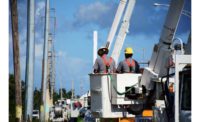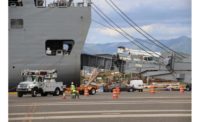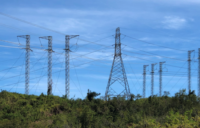At least 3,000 workers, 62,000 poles, 338 towers and 6,500 miles of wire will be needed to rebuild Puerto Rico’s electric grid, which a month after Hurricane Maria is at only 20% capacity. If everything goes right—and that’s a big if—most of the island’s 3.4 million people should have power by the end of May.
“It could take almost a year. I’d like to think we can get that done by the end of May, but there are going to be some people on Puerto Rico in very, very remote locations that are going to need [generator] power for a long, long time,” Lt. Gen. Todd Semonite, commanding general of the Army Corps of Engineers, said in an Oct. 20 Pentagon briefing.
Puerto Rico Gov. Ricardo Rossello (D) says he hopes 30% of the grid would be up by the end of October, 50% by November and 95% by the end of the year, but “those are stretch goals,” Semonite said. Within the U.S. Virgin Islands as of Oct. 24, St. Thomas had 30% and St. Croix had 1.6% power; no grid power had been restored on St. John, but the utility there expects 90% of the power to be restored by Christmas. Semonite didn’t address whether that estimate is realistic for the smaller territory, which has a population of about 100,000 and a grid one-tenth the size of Puerto Rico’s.
After essential power is restored, it could take many more years and millions of dollars to rebuild the grid to be more resilient and less dependent on imported fossil fuels—goals Rossello and U.S. Virgin Islands Gov. Kenneth Mapp (I) endorse.
“They should really advocate for a second pot of money for modernization and hardening,” Gil Quiniones, president and CEO of the New York Power Authority, said on an Oct. 17 New York Slant Podcast. “That has to come next.” Without it, “after the next Maria, we could be spending a lot more,” he added. NYPA is assisting Puerto Rico’s Electric Power Authority with the recovery.
The extent of the damage and the rebuilding effort is historic. “I’ve never seen anything like this,” says Giovanni Lopetrone, a contractor for Louis Berger in the U.S. Virgin Islands.
Almost every worker, piece of equipment, mile of cable and pole has to be shipped or flown to the Caribbean islands. Ports in Puerto Rico and the Virgin Islands are at reduced capacity. Some contractors are living in hotel rooms, but others are living on container ships. Thousands more yet to arrive will be housed and fed in tent cities.
“When you look at the different factors, the different challenges you face in a disaster, Puerto Rico pretty much checks all of the boxes: terrain, communication, resource challenges—financial and physical. It’s really a confluence of challenges,” says Tom Lewis, president of Louis Berger U.S., which has been contracted by the U.S. Army Corps of Engineers to provide and service about 600 generators and—for the first time—help businesses to keep their own generators operational. The company has about 500 people working on the generator mission in Puerto Rico and the Virgin Islands.
Partnerships
The grid-rebuilding mission is not a “core competency” of the Corps, Maj. Gen. Ed Jackson, deputy commanding general for civil and emergency operations, said at a recent American Society of Civil Engineers conference. So, the agency has had to create partnerships and craft new contracts for the work in Puerto Rico.
“I think the thing that neither [the Federal Emergency Management Agency] nor Puerto Rico nor [the Corps] understood was the severity of the storm and the magnitude of the destruction when it came to the power grid,” Semonite says. “So, this is where we did not have a contract on the shelf to be able to say, ‘Rebuild the entire grid.’ ”
The Corps is working with FEMA; the Puerto Rico Power Authority (PREPA); the Jacksonville, Fla., and New York public power authorities, and the Energy Dept., among others.
On Oct. 17, the Corps awarded Fluor a $240-million, six-month contract to augment efforts to rebuild the grid in Puerto Rico. The contract could go up to $1.3 billion, Semonite says. Fluor could not detail the type of work it will be doing as part of the contract, but the company has a long history on the island, having helped to build the Puerto Rico’s first oil refinery in 1955 and, recently, a coal plant.
The Corps also has awarded a $35-million contract to Weston Solutions to install a 50-MW generator at San Juan’s main power plant. Another $40 million contract was awarded to PowerSecure to augment the restoration effort.
The island needs about 2,500 MW of power; currently, it has about 579 MW on line, Semonite says. Most of the territory’s power comes from seven plants that operate on natural gas, oil or coal. There are an additional seven solar and wind plants and 21 hydro facilities, including the Guajajara Dam, which was critically damaged following Hurricane Maria and will have to be rebuilt, Semonite says.
PREPA has issued its own contracts with providers, including a much-reported contract with Whitefish Energy of Montana. Whitefish was hired by PREPA following Hurricane Irma, was on site on Sept. 26 and continues to work under a $300-million contract formalized on Oct. 19, a company spokesman said. Another $200-million contract was awarded to Mammoth Energy Services subsidiary Cobra Acquisitions.
Whitefish’s efforts are focused on reconstructing roughly 100 miles of lines in the island’s rural and mountainous areas. The company has mobilized 300 crew members and intends to have 700 more workers on the island soon.
Chuck Chiames, who is handling public relations for the 2015-founded company, says it is a challenge for crews on the ground. “We are finding things every day that no one knew existed,” he says, citing as an example transmission towers in such disrepair that they must be replaced before they can be restrung with power lines.
Semonite confirmed the horrendous state of the Puerto Rico grid, which hasn’t been maintained because the utility is bankrupt.
“There’s a lot of the grid that wasn’t built to code. A lot of the grid was damaged. Some of these lines didn’t have enough poles—they had too much span between the cables. Some of the poles were cracked by other storms,” he says.
Workers in the Virgin Islands have found some transmission infrastructure inadequate, too. “As we’ve been digging, we’ve found that a lot of these poles aren’t buried where or how they should be. They’re too high up and often have rocks piled up to keep them in place, but that’s not going to withstand 150- or 200-mile-per-hour wind,” says Will Schnyer, a DOE safety manager.
Rebuilding to Code
The Corps expects its rebuilding effort will bring the island’s grid up to code. There’s some wiggle room under the federal Stafford Act, which allows for a hazard-mitigation increase of 10% to 15% to rebuild to a more-resilient level—elevating a substation in a floodplain or replacing wooden poles with metal ones, for example—says Lewis of Louis Berger.
But more comprehensive, long-term resiliency measures will require coordination by the power authority and the territorial government, Lewis says. Louis Berger has been talking with technology providers and private financiers interested in bringing different energy options to the island, Lewis said. “We are heavily engaged” in the business development phase of those plans, though those talks are preliminary, he added.
Tesla CEO Elon Musk has offered to rebuild the grid using solar power and batteries, an opportunity Rossello has discussed with Musk on his Twitter account. Virgin CEO Richard Branson says he will start a green-energy fund to power the Caribbean with wind and solar power.
Quiniones says New York hopes Puerto Rico will follow the lead of the Long Island Power Authority after Superstorm Sandy. After restoring basic power, the authority secured an additional $730 million in federal funding to modernize and harden the grid and add solar and wind power. Lewis says that now is the time to pivot toward the long-term mission of how best to rebuild the grid for the future. “If it’s done right, it can be very effective and successful. If it’s done wrong, there will be a lot of money spent” and not much to show for it, he cautions.
Virgin Islands Struggles
The U.S. Virgin Islands Water and Power Authority (WAPA) is forecasting that most of the power will be restored by the end of the year. But that seems optimistic, considering the power lines and poles littering the streets on the islands.
“The sound of a hurricane, after it’s passed, is chainsaws,” says Robert Dinion, owner of Energy All Over, a solar installation company in St. Thomas. “Then, the sound is generators, and it’s still generatorville out here.”
While the pre-storm grid wasn’t as decrepit as it was in Puerto Rico, the two back-to-back storms devastated the Virgin Islands. Louis Berger has installed 100 generators across the territory. Energy Dept. linemen have brought back power to parts of St. Thomas. Later this months, divers will perform assessments of submarine cables to St. John, Hassel Island and Water Island as preparations are made to restore electrical service to those areas, according to WAPA. The territory had a greater reliance on renewable power than Puerto Rico: Ten percent of St. Thomas’ power came from a 4.2-MW solar array. But the solar power didn’t prove resilient. Panels from the array were knocked from their racks, broken in half or shattered. Under contract with WAPA, owner AES Distributed Energy is trying to figure out how to rebuild the now-dangerous array, says a WAPA spokesperson.
“This is what happens when a storm hits a hill of ground-mounted solar panels,” says Dinion, who started installing rooftop solar on St. Thomas in 2008.
Repairing the array is going to be challenging, Dinion says. “Over 50-volts DC power will cook you like a hotdog. The broken wires hanging off those panels can have 450-volts DC running through them,” he notes. The breaker for a string of panels can be turned off, but when the connection is broken and wires are exposed, the panels continue to electrify the wires, says Dinion.
The only safe approach seems to be working at night, when the panels are not producing electricity. Big-grid power doesn’t make sense for the islands, which should look to microgrids, Dinion suggests.
Schnyer alternatively suggests that, since St. Thomas’ rocky terrain would make burying the lines underground difficult, the most critical lines, from power plants to substations, could be put placed in concrete encasements along the road.
For now, the territory is focused on getting basic power. “The Virgin Islands have suffered tremendously. We will recover and build stronger,” says Jean Forde, a territory senator. “We’re thankful for having the Army Corps of Engineers here. However, many individuals feel that the process is a little slow.”
Semonite acknowledged the slow pace. “I’m not satisfied where we’re at right now,” he said on Oct. 20. “I’d love to be able to say we could … make [these timelines] a lot quicker. And I think [what makes this job so hard is] the uniqueness of both the deterioration of the grid in Puerto Rico—and the Virgin Islands has just as many challenges on electricity as Puerto Rico does—as well as the fact that it’s a remote site with a massive logistics requirement.”














Post a comment to this article
Report Abusive Comment